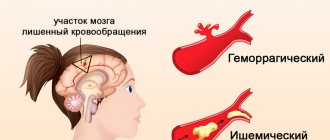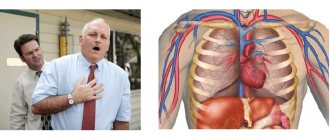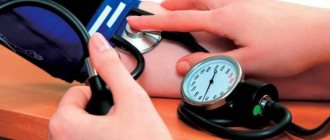- Etiology
- Symptoms
- Diagnostics
- Treatment
Heaviness in the heart area is a symptom of a certain pathological process, which is characterized by a feeling of discomfort in the left side of the chest and may be accompanied by lack of air, pain, and rapid pulse. It should be noted that, despite the localization of the manifestation of the symptom, this is not always a sign of disorders specifically in the cardiovascular system. Only a doctor can determine the etiology of heaviness in the heart area based on the diagnostic results. Self-medication is unacceptable.
Causes
For a feeling of heaviness to arise in the chest, sometimes familiar circumstances are enough to provoke it:
- fluctuations in atmospheric pressure (weather dependence);
- change of time zones, climate;
- binge eating;
- bad habits;
- overwork
Such sensations of discomfort go away on their own after a short rest and adaptation period. But more often, heaviness in the heart area is a manifestation of a pathological process in it or nearby organs. Therefore, the causes of pathology are divided into cardiac and extracardiac.
| Diseases | The essence of the process |
| Cardiological | |
| Angina pectoris | The reason is myocardial ischemia after physical exertion or severe mental stress, symptoms of heaviness in the chest disappear after a short rest, do not require additional intervention |
| Myocarditis | The essence is inflammation of the middle lining of the heart, characterized by chest discomfort, sometimes shortness of breath after exercise, tingling in the heart area |
| Pericarditis | This inflammation of the serous membrane of the organ with fever, nagging pain in the region of the heart, heaviness behind the sternum forces a person to look for a comfortable position in order to reduce discomfort |
| Cardiomyopathy | Functional changes in the myocardium, spontaneously causing heaviness in the chest, increasing after exercise, not relieved by Nitroglycerin, accompanied by pastiness, constant fatigue |
| Heart defects (congenital and acquired) | The essence is a violation of hemodynamics and metabolism with heaviness in the chest area |
| Mitral valve prolapse | The reason is connective tissue dysplasia, heaviness behind the sternum persists for a long time, is not relieved by Nitroglycerin |
| Heart failure | Chest pain is combined with shortness of breath, rapid weight gain, swelling of the legs, cough, heart rhythm disturbances |
| Arrhythmias | Irregular heart rhythm accompanied by shortness of breath accompanies heaviness in the chest due to poor circulation |
| Extracardiac | |
| Stress | It causes the release of adrenaline into the blood, which spasms blood vessels, causing myocardial ischemia and heaviness behind the sternum; long-term stress causes cardioneurosis |
| VSD | Pathology of the nervous system affects vascular tone, changes the innervation of internal organs, causes fluctuations in blood pressure, tachycardia, arrhythmia, heart pain resembling angina pectoris |
| Hormonal changes | The reason is an imbalance of hormones responsible for vascular tone, blood supply to internal organs, which is accompanied by heaviness in the chest (puberty, menopause, pregnancy, menstruation) |
| Aortic aneurysm | When a vessel stratifies or ruptures, the pressure drops sharply, the skin turns blue, heaviness occurs behind the sternum, dizziness, and the person loses consciousness |
| TELA | Myocardial power supply due to a thrombus in the pulmonary artery causes severe pain in the heart, fraught with instant death if the lumen of the vessel is completely obstructed |
| Thoracic radiculitis, osteochondrosis | The essence is irritation or compression of the nerve endings of the spinal column, manifested by heaviness in the chest, which intensifies with movement, and is not relieved by nitroglycerin |
| Esophagitis, peptic ulcer | Heaviness in the left half of the chest is associated with food intake, symptoms of the main pathology prevail, pain is relieved by antacids, indifferent to Nitroglycerin |
Diagnostic methods
Diagnosis of the causes of compression in the chest area is carried out by a cardiologist. The doctor clarifies the nature of the pain, the period and circumstances of its occurrence. During an external examination, it determines blood pressure, the presence of edema, neoplasms, rhythm disturbances, heart murmurs, changes in skin color, bruises. Sometimes consultation with other specialists is required: neurologist, gastroenterologist, endocrinologist. These specialists can also tell why the heart is compressed and pinched.
Then the following diagnostic measures are prescribed:
- electrocardiogram (ECG);
- daily ECG monitoring;
- radiography;
- coronary angiography;
- ultrasound examination (ultrasound).
In addition, a general and biochemical blood test will be required, and in some cases a specific one. If these examinations fail to determine the causes of pain, the cardiologist will refer you to computed tomography (CT) or magnetic resonance imaging (MRI). Research allows you to obtain a high-quality image of the area of the body being examined and track all the changes that have occurred in it.
Symptom appears on the right
Heaviness in the region of the heart on the right, accompanied by weakness and shortness of breath, occurs as a result of many reasons, which can be differentiated by a complete clinical and laboratory examination:
- for example, a physical examination reveals a connection between raising the right arm and retrosternal discomfort, which indicates neurological disorders;
- an increased heart rate, which can be seen on an ECG, indicates cardiovascular pathology;
- heaviness on the right with fever, cough, shortness of breath makes one think about respiratory problems and requires an x-ray examination;
- if discomfort behind the sternum on the right occurs after eating, the cause is gastrointestinal diseases, an appropriate examination is needed.
The scope of laboratory and instrumental methods is determined by the doctor.
Nature of pain in the heart area
The description of suffering by the patient himself is very important at the first stage of diagnosis. It is the detailed description of pain that allows the doctor to navigate in the direction of the search and reduce additional examination methods to the necessary minimum.
When questioning the patient, the following are taken into account:
- conditions for the occurrence of pain (during or after exercise, at rest, association with food, at night or during the day)
- the nature of the sensations (pricks, squeezes, aches, cuts, presses, constantly or periodically)
- duration of pain
- after which they stop.
Symptoms
Any heaviness in the chest of cardiac etiology has common symptoms:
- pain and feeling of chest compression;
- weakness, weakness, chronic fatigue;
- pale skin;
- hyperhidrosis;
- blood pressure fluctuations;
- nausea;
- hyperthermia;
- faintness, fainting;
- dyspnea;
- tachycardia;
- panic attacks.
Such clinical manifestations are a reason to seek specialized medical help. Ignoring symptoms can be fatal.
If the causes of heaviness behind the sternum are of a different etiology, then the person is concerned about:
- chest pain radiating to the back;
- migraine;
- ataxia;
- nausea, vomiting;
- dyspepsia;
- heartburn, bitterness in the mouth
These symptoms also require contacting specialists to rule out serious complications.
Snoring and sleep problems
This is not only a sign of respiratory system disorders, but also a possible symptom of heart disease. Weak snoring, which stops after changing your posture, should not frighten you or your family. It becomes dangerous if breathing stops for a few seconds during sleep, a feeling of suffocation occurs, which leads to a sharp awakening.
Features of treatment, complications
If there are unpleasant sensations in the chest, a “heaviness has fallen” on the heart, at home you should:
- call an ambulance;
- calm the person down, put him or her in a comfortable position;
- provide access to fresh air;
- loosen tight clothing;
- if the attack is not the first time, and there are medications prescribed by the doctor, you need to take them (for example, Nitroglycerin, Corvalol)
If it is angina pectoris, the attack is stopped before the doctors arrive. In case of more serious pathology, hospitalization is necessary.
When do you need a doctor?
It is imperative to consult a doctor if you have the following symptoms:
- burning sensation in the chest, increasing in intensity;
- a sharp drop in blood pressure (below 80 mm Hg) or increase (more than 180 mm Hg);
- fainting;
- cough with blood;
- no response to Nitroglycerin.
This requires emergency medical care, and you must remember that each subsequent attack can be fatal. Each of us is primarily responsible for our own life and health.
Medicines
Drug therapy is divided into symptomatic and pathogenetic. Symptoms are relieved with coronary dilating drugs: Validol, Nitroglycerin. Blood flow to the myocardium relieves the feeling of heaviness. Pathogenetic includes:
- anticoagulants: Clexane, Heparin, Flenox;
- antiplatelet agents: Clopidogrel, Aspirin;
- statins: Rosuvastatin, Simvastatin;
- antihypertensive: Amlodipine, Enap, Valsartan;
- beta blockers: Metoprolol, Nebivanol, Atenolol;
- Nitrates: Nitrong, Dikor-Long.
If conservative therapy is ineffective, surgical methods are used:
- stenting – installation of a metal structure in the area of narrowing of the vessel;
- coronary artery bypass grafting – creation of additional blood flow bypassing the stenosis;
- installation of a pacemaker - an electronic device that analyzes the heart rhythm, its conductivity and corrects them with electrical impulses;
- treatment of heart defects with occluders - an umbrella patch that covers a defect in the chambers of the heart
The method of therapy depends on the etiology.
Pain in the heart: what to do
If you suspect problems with your heart, it is better to reassess the risks and immediately consult a physician or cardiologist. After questioning and examination, the doctor will prescribe:
- urine and blood tests
- fluorography of the chest organs
- ECG (interpretation)
- if necessary, bicycle ergometry, treadmill and echocardioscopy.
This tactic will allow you to react in time to real heart disease or quickly verify its absence and preserve excess nerve cells. In addition, cardiac pathologies often mask other serious and not so serious diseases, which it is also advisable to diagnose and treat in a timely manner.
Author:
Postnova Maria Borisovna general practitioner
Swelling of the legs and feet
If the heart doesn't work properly, not all of the blood goes up - some of it goes back down. The veins become congested and fluid begins to accumulate in the tissues. This causes swelling in the lower legs and, less commonly, in the abdomen. In heart failure, the situation is aggravated by kidney damage, which also causes fluid to accumulate. A person sees swelling throughout the body, weight gain.
How to distinguish cardiac pathology from another
There are a number of symptoms that in 80% help to distinguish pain of cardiac origin from any other:
- sudden onset, rarely - in the morning or at night;
- discomfort is intense, burning, tearing the chest;
- irradiation to the left arm, shoulder, shoulder blade, jaw;
- sometimes the pain affects the back or abdomen;
- not associated with breathing and changes in body position;
- the duration of the attack is no more than 40 minutes (maximum – an hour);
- relieved with narcotic analgesics (Promedol).
Any other signs, especially connections with breathing, eating, and changes in body position, indicate a non-cardiac pathology.










